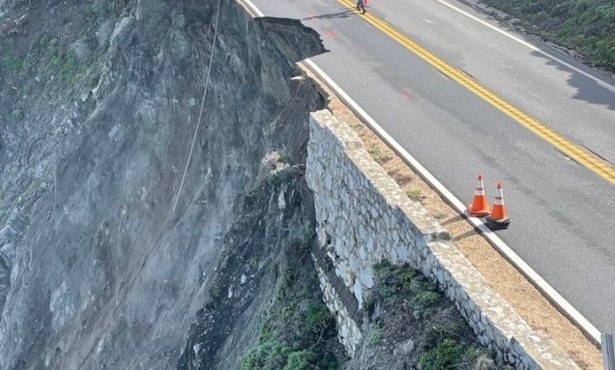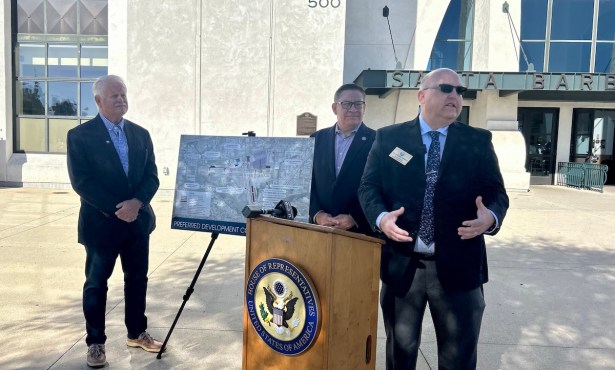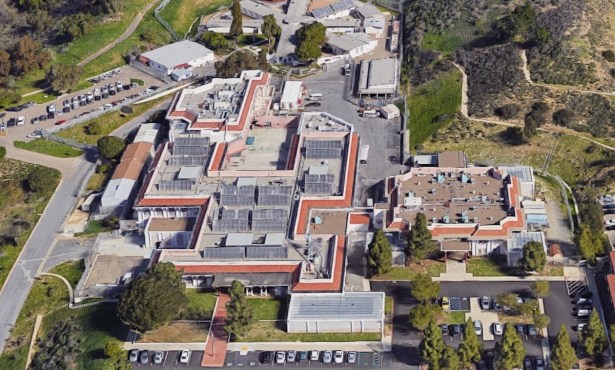Copper in the Water Can Kill Dogs
Montecito Man Battles with Utilities to Determine Source of Electrical Current in His Water Pipes

Early last year, Trev Broudy’s golden retriever got very sick. He took her to four veterinarians to try to figure out why she had severe anemia and was deathly ill. One suggested he put her down, she was so sick. After his dog dropped from 80 to 60 pounds in a couple of months, Broudy decided to start giving his filtered drinking water to 8-year-old Bacall instead of tap water, and she slowly got better. About six months in, a vet in Tahoe thought it was some kind of poisoning, maybe metal poisoning.
Then Broudy heard from the Montecito Water District in September. The district has sampled his tap water periodically as part of its water quality testing program, but September’s copper reading was 1,530 parts per billion — well above the state’s “action level” of 1,300 ppb at which corrosion had to be controlled. The district couldn’t believe the result was so high and tested Broudy’s water again; the result was the same. They told him not to drink the water. Broudy immediately thought of Bacall.
High levels of copper can irritate the human digestive tract or even cause organ damage. Dogs don’t metabolize copper as well and are considered more susceptible to copper overload.
This past week, another test revealed 2,450 ppb in his water. He also learned two dogs up the street had died.
Get the top stories in your inbox by signing up for our daily newsletter, Indy Today.
The Montecito Water District tests 50-100 households every three years for lead and copper under state guidelines. Nick Turner, general manager for the district, said they often found corrosion is due to a water softener, which Broudy does not have. A high reading in Montecito tends to be in the 100 ppb range for copper.
“This is definitely an outlier in the program,” Turner said. “We all want to know what the problem is and to know what the limits are.” But the district’s opinion in November was that the problem was only at Broudy’s home, and the problem was his to deal with.
For the past four months, Broudy has searched for “copper” and “water” information online, finally running across stories of “stray current” on the East Coast. The research has been no simple matter for Broudy. He’d been clubbed over the head during a mugging about 20 years ago and left with serious damage to his vision. Broudy relies on a special program that speaks written information on his computer. But his first good lead was a video.
“I saw on YouTube that electrolysis on copper pipes could degrade the pipe,” Broudy recalled, and that the presence of electricity could be determined with a Gauss meter. “The thing that’s so nuts,” Broudy went on, “is that I had a Gauss meter in the garage,” a remnant from living for 25 years in Los Angeles under a high-power line; he’d measured the electromagnetic output periodically to make sure it wasn’t hitting the potential cancer level of 3 milligauss.
At his home on Middle Road just off Coast Village Road, Broudy found that the copper pipes running to the house pegged the meter at 30 milligauss. He started making calls, each person telling him to call the next: a plumber, an electrician, the Gas Company, Southern California Edison, Cox Communications. “The gas guy gets a voltage meter out,” Broudy said, and measured 8 volts at appliances that were turned off and 45 volts at the gas meter. Don’t touch anything, he told Broudy, because you don’t want to cause an explosion. (Fifty volts is considered dangerous to humans.)
Edison crews spent three days tracing the mysterious electricity charging Broudy’s water pipes, eventually telling him “all the stray current that’s supposed to go back to Edison is somehow finding the path of least resistance, my home,” Broudy recounted. Even with the power cut to his house, the electricity reading at his copper pipes was at 2 amps (0.1 to 0.3 amps can be lethal). SoCal Edison issued a statement that it was investigating the problem with other utility companies and did not want to speculate about Broudy’s concerns.
Broudy said the Edison crew had traced the source to a Cox Communications “pedestal” across the street. Cox insisted to Broudy that they’d done no work involving the pedestal for 20 years — though he recalled they’d worked in the street within the previous year installing “high-speed internet for businesses,” which the crew had told him when he complained about the mess. Getting no plausible answer from Cox, Broudy submitted a complaint to the California Public Utilities Commission. Cox later asserted no current ran from its equipment to his house.
Last week, Broudy talked with Montecito Water district employees, who were on his street taking amp readings, some of them positive for electricity. The district stated they were “performing additional testing to confirm that this issue is an isolated occurrence and does not exist at other locations.” On Sunday, a district employee returned to Broudy’s house, disconnecting the water pipes at the meter, at Broudy’s suggestion, and finding no current on Broudy’s side but a hot current on the district’s side.
To say that Trev Broudy is frustrated doesn’t begin to describe it. He’s just about lost his voice, he’s talked to so many people these past many days. “I am working so hard to get this worked out, but this is really frustrating. I just want people to know this could be a problem for them and their dogs,” he said. On Monday, he’d spoken with the neighbor who lost her two dogs and learned her vet had diagnosed copper poisoning. She was now having her water tested.

Nonetheless, Broudy was cheered by the discovery on Tuesday that adding a “dielectric” fitting to the pipe system disrupted the electric current along the copper. “It worked 100 percent,” he said, “zero amperage and zero gauss.” And Broudy is nothing if not thorough: He’s sending a pipe sample to a lab on the East Coast to analyze how much copper is left in the tubing — his research showed a year of electrolysis can start leaks. But the source of the electricity? It’s still a mystery.
Every day, the staff of the Santa Barbara Independent works hard to sort out truth from rumor and keep you informed of what’s happening across the entire Santa Barbara community. Now there’s a way to directly enable these efforts. Support the Independent by making a direct contribution or with a subscription to Indy+.




You must be logged in to post a comment.